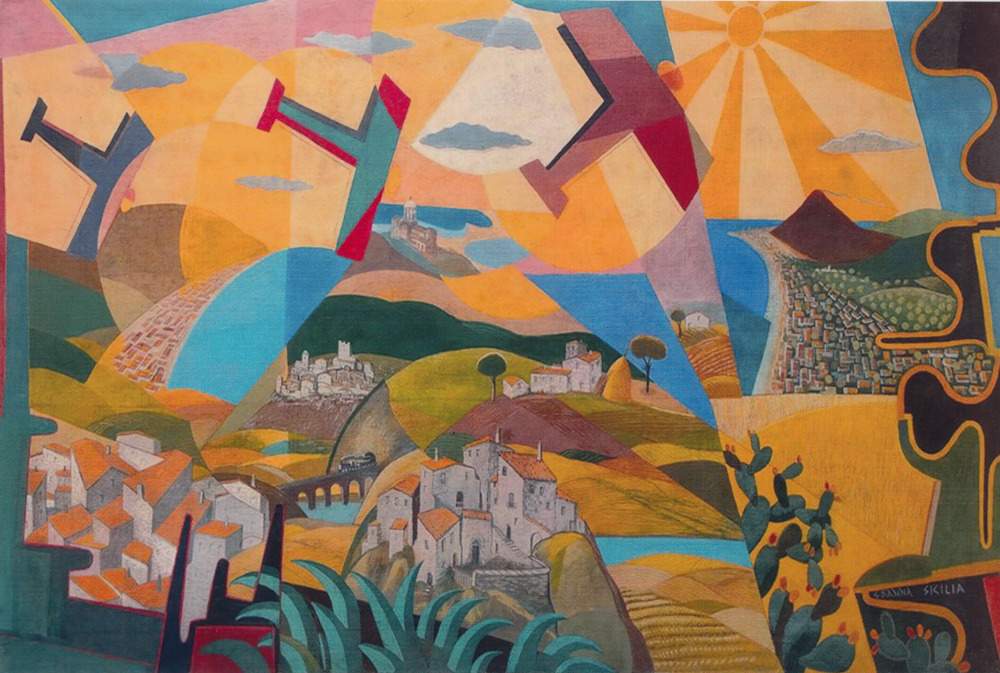Giulio D'Anna's fantastic aeropainting on display in Monza
From Nov. 26, 2022 to Jan. 14, 2023, the Leogalleries exhibition spaces in Monza will present the exhibition L’aeropittura fantastica di Giulio D’Anna. The anthological exhibition, curated by Maurizio Scudiero and Salvatore Carbone, is intended as a tribute to Sicilian artist Giulio D’Anna.
D’Anna went to the Reggio Calabria Biennale in 1927 as a journalist, where he met Mino Somenzi, one of the authors of the Manifesto dell’Aeropittura, from whom he learned the concepts ofAeropittura. From 1928 to 1931 he expressed himself inFantastic Aeropainting, his own personal and original interpretation of the Manifesto. He would then continue to paint while remaining adherent to the norms and canons written and shared by fellow artists of the period, yet maintaining the distinctive and unique features of his style. For D’Anna, 1931 is a watershed year, and it is around this moment that the Leogalleries exhibition unfolds.
Twenty works by the artist, considered among the pioneers of aeropainting and among the first to make it his own, will be on display. Among the works featured will be Sicilia of 1936: a work first exhibited in the exhibition A Journey into Futurism: from Boccioni to Depero in Cortona, and now on view in the solo show in Monza. Speaking of Sicily, curator Salvatore Carbone explains that “it is a summary of fifteen years of aeropainting. In this work D’Anna has been able to represent his entire region from Trapani to Catania, a set of symbols such as the Madonna of Tindari and Mount Etna, the train and the Simeto river that joins the two parts of the painting. At the center of the work is the fantastic aeropainting that is the author’s signature, with the landscape painted with precision and rich in detail.”
Also present are works traceable to polymaterism. Important are the collages. “Let’s not forget that D’Anna was also a bookseller; for him, printed paper was pictorial language,” Carbone stressed.
“Giulio D’Anna,” commented curator Maurizio Scudiero, "has long been, and unjustly, snubbed by militant critics, as, moreover, have been most of the ’borderline futurists’ or peripheral areas. First, because until the 1980s, that is, until Enrico Crispolti with his exhibition Ricostruzione futurista dell’universo (Futurist Reconstruction of the Universe ) ventured beyond the threshold of 1915, attention on Futurism was restricted to the circle of the founders and in particular to Boccioni. And secondly because before the ’discovery’ of Aeropittura (which dates 1929) it was problematic to deal with Futurists like D’Anna, but also Tato, and then Ambrosi, Di Bosso, etc.,“ he continued. ”Recently, in the last fifteen years, the valorization of D’Anna has started first from the punctual studies of Anna Maria Ruta and the Archives of Sicilian Futurists, and then also from abroad, that is, from the exhibition held in London in 2018, which has sanctioned the international importance of the artist."
For info: www.leogalleries.it
Hours: Tuesday through Saturday from 10 a.m. to 1 p.m. and 3 p.m. to 7 p.m.
Image: Giulio D’anna, Sicily (1936-1937, oil on canvas, 105 x 180 cm)
 |
| Giulio D'Anna's fantastic aeropainting on display in Monza |
Warning: the translation into English of the original Italian article was created using automatic tools. We undertake to review all articles, but we do not guarantee the total absence of inaccuracies in the translation due to the program. You can find the original by clicking on the ITA button. If you find any mistake,please contact us.





























